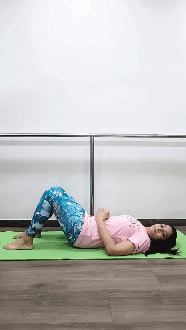3 Exercises On How To Cure Back Pain During Pregnancy

Pregnancy is a magnificent journey full of joy and anticipation, but back discomfort is a typical problem. Hormonal changes, weight increases, and centre of gravity adjustments can cause back pain in 50% to 70% of pregnant women. Despite its prevalence, safe and effective exercises exist to relieve and manage chronic discomfort.
In this blog post, a pregnancy fitness trainer, Dr Shivani Sanghvi, recommends exercises for back pain in pregnancy. Because she knows a lot about pregnancy fitness, Dr. Sanghvi stresses the importance of individualised exercises that are good for your overall health and ease back pain.
Workouts during pregnancy need to be safe and helpful for many reasons. We want pregnant women to have the information and skills to handle their pregnancy confidently.
Strengthening spine-supporting muscles, improving balance, and increasing flexibility make pregnancy joyful. Stay tuned for thorough back health guidance throughout this momentous time.
Exercises to Cure Back Pain During Pregnancy
Back pain is the main symptom of every pregnant woman. So, how to cure back pain during pregnancy? Include targeted exercises in your plan to feel better and get through the change. The Wall Stretch gently relieves lower back stress and improves flexibility. The Pelvic Bridge exercise strengthens pelvic and back muscles for pregnancy stability.
Finally, the Spine Twist and Stretch reduces stiffness and relaxes the spine. When done correctly, these exercises lower back pain and make pregnancy healthier and more comfortable. Consult your doctor before starting new exercises during pregnancy.
1. Wall Stretch Exercise
Wall stretch exercise is a mild therapeutic workout that relieves lower back strain and improves flexibility. It helps pregnant women in dealing with discomforts. This exercise also helps them in staying healthy during pregnancy.

Instructions on how to perform wall stretching
- Positioning:
Face a wall with shoulder-width feet. Place your hands on the wall at shoulder height, at a comfortable distance.
- Foot Placement:
Step back with one foot while keeping your heels down. Stretching is stable with this staggered stance.
- Execution:
Allow your hips to fall back as you lean forward—the lower back and hip muscles contract, deepening the strain.
- Breathing:
Hold the stretch for 5-10 counts, breathing deeply. Take some deep breaths through your nose and mouth to relax.
- Repetition:
Continue stretching for ten counts on each side. Changing sides balances flexibility and relieves lower back and hip muscles.
Benefits of the wall stretching exercise
- Reduces Lower Back Tension:
The Wall Stretch targets the lower back, a common pregnancy pain point. This exercise relieves lower back stiffness by elongating and releasing.
- Improves Hip Flexibility:
The Wall Stretch increases hip flexibility while squatting. The body changes throughout pregnancy, which is vital for the hip joints. Flexibility boosts mobility.
- Improves Posture:
In addition to relieving pain, the Wall Stretch improves posture. Regular practice aligns the spine and pelvis, decreasing back strain and promoting a more upright and pleasant posture.
- Increases Blood Flow:
Wall Stretches increase blood flow by deliberately stretching. Maternal and foetal health depend on improved circulation that provides oxygen and useful nutrients to the growing baby.
- Provides Relaxation:
Beyond its physical benefits, the Wall Stretch relaxes deeply. The thoughtful and purposeful exercise connects the body and mind, reducing stress and tension - essential for pregnancy well-being.
Incorporating the Wall Stretch into a pregnant workout provides a holistic approach to physical health. The Wall Stretch is a useful pregnant exercise that relieves lower back pain, improves flexibility, and relaxes. Always check your doctor before starting a new fitness plan during pregnancy to ensure it fits your health needs and pregnancy status.
Also Read: 15 Safe Cardio Exercises for Pregnant Women
2. Pelvic Bridge Exercise
The Pelvic Bridge exercise is a staple of prenatal fitness, strengthening the back and pelvic muscles for stability and support. This low-impact, back-lying exercise promotes maternal well-being.

Instructions on how to perform pelvic bridge exercise
- Body Position:
Initiate by lying right on the back. Then, slowly bend your knees at 90 degrees with feet flat right on the floor, hip-width apart. Be sure your spine is neutral.
- Arm Position:
Put your arms alongside your body, palms down. This stabilises your upper torso and shoulders throughout the workout.
- Lift Hips:
Start by elevating your hips to the ceiling. Emphasise glute activation by drawing a straight line from shoulders to knees. This strengthens the core and posterior chain.
- Hold and Focus:
Hold the bridge position for ten breaths. Glute squeezes and pelvic floor engagement is key. This is essential for optimal exercise benefits and stability.
- Repetition:
Repeat the sequence five times. Regularly doing this bridge exercise helps improve core strength, glute activation, and body stability.
Benefits of the pelvic bridge exercise
- Pelvic Floor Muscle Strengthening:
A powerful tool for conditioning and strengthening pelvic muscles is the Pelvic Bridge. They are crucial to labour and delivery; thus, their strength makes delivery easier.
- Lower Back Stabiliser:
Engaging the core and glutes during the Pelvic Bridge stabilises the lower back. This involvement lowers discomfort and pain and provides support as the body transforms during pregnancy.
- Improves Posture:
A strong back and pelvis are essential for good posture. The Pelvic Bridge strengthens body alignment by targeting these locations. Improved posture reduces spine strain and improves comfort.
- Improves Circulation:
This exercise improves blood circulation with the bridge position. Moms and kids get more oxygen and nutrients when their circulation is better.
- Reduces Back Pain:
Regular use of the pelvic bridge in prenatal exercise prevents back discomfort. The training also strengthens and stretches targeted muscle areas, relieving pain.
The Pelvic Bridge is a simple but beneficial maternal health exercise. It improves mental, emotional, and physical wellness. Like any pregnancy exercise, consult your doctor or midwife to ensure the Pelvic Bridge is safe for you and your baby and matches your health needs.
Also Read: C-Section Recovery: Best Exercises for Indian Moms
3. Spine Twist and Stretch
The Spine Twist and Stretch exercise is moderate but beneficial for pregnancy-related spine flexibility and back pain. This activity is useful for prenatal fitness because the body changes during this time.

Instructions on how to perform spine twist and stretching
- Starting Position:
Sit right on the floor with both legs straight ahead. Keep your spine tall and shoulders relaxed. This stance sets the stage for further moves.
- Place Cross-Leg:
Place one foot flat on the floor and cross one leg. This provides stability so you may focus on the spine twist while keeping balance and control.
- Place Elbow:
Place the opposing elbow outside the bent knee. This activates the core and prepares the torso for the twist, maximising the stretch.
- Gently Twist and Inhale:
Take a deep breath, turn, and gradually twist your spine. The smooth, controlled movement emphasises spine elongation. This controlled twist relaxes and increases flexibility.
- Duration and Focus:
Focus on mindfulness while holding the stretch for five breaths. Feel the slight twist in your spine and watch for tension releases with each inhalation.
- Repeat and Symmetry:
Repeat the stretch on the other side for balanced flexibility training. Do ten reps per side to symmetrise your spine's range of motion.
Benefits of the spine twist and stretching exercise
- Spinal Flexibility Upgrade:
The Spine Twist and Stretch emphasise spinal flexibility. Twisting enhances spine mobility, minimising pain. The body needs this flexibility to accommodate the growing uterus and change its centre of gravity during pregnancy.
- Stimulates Abdominal Muscles:
Twisting engages the core, stimulating abdominal muscles. The abdominal muscles contract while the torso turns, providing a mild workout and back support. This stimulation maintains abdominal strength, improving posture and core stability.
- Reduces Lower Back Tension:
Due to weight shifts and hormonal changes, pregnancy can cause lower back pain. The Spine Twist and Stretch relieve lower back tension. This tailored relief is crucial for expecting moms' comfort.
- Promoting Circulation:
Improved spine flexibility from this workout improves circulation. The twisting motion helps blood circulate through the spine, surrounding muscles, and tissues. This allows the mother and baby to develop optimally.
- Facilitates Rest:
In addition to physical benefits, the Spine Twist and Stretch are rhythmic and contemplative. Relaxation via purposeful counting and regulated movements reduces stress and promotes well-being. This becomes a vital self-care aspect during pregnancy's physical and mental changes.
The Spine Twist and Stretch exercise addresses pregnancy's physical concerns in multiple ways. This exercise helps expectant mothers prioritise their health by improving spinal flexibility, core muscle engagement, lower back stress, circulation, and relaxation.
To guarantee safety, consult a doctor before exercising during pregnancy. When added to a prenatal workout routine, the Spine Twist and Stretch can improve mother and baby comfort and health.
Also Read: Prepare for Labour with these 3 Ball Exercises for Moms-to-be
Significant Safety Tips and Precautions For Exercising During Pregnancy
Regular activity during pregnancy can benefit health, but mother and child safety must come first. Before starting an exercise routine while pregnant, consult a doctor. A doctor can advise based on the patient's health and risk factors. Open discussion regarding pre-existing conditions is essential for safe exercise.
Pregnant women must monitor their bodies. Watch for tiredness, dizziness, and shortness of breath as the body transforms. How the body feels on any given day should determine training time and intensity. After the first trimester, avoid overexertion and lying flat on your back to prevent uterine blood flow obstruction.
Low-impact workouts are gentler and reduce harm. Walking, swimming, stationary cycling, and prenatal yoga are good cardiovascular workouts for joints and ligaments. For flexibility and exercise readiness, the body needs warm-up and cool-down exercises.
Hydration is crucial during pregnancy when blood volume rises. Heat from dehydration can harm the foetus. Wear loose, breathable attire and work out in a ventilated area.
Key Takeaways
In this blog post, we discussed exercises for back pain during pregnancy. Exercise improves flexibility and strength, making pregnancy simpler. Pregnant women should see their doctor before starting an exercise plan to ensure it suits their health and gestational stage.
Many pregnant women use these exercises to treat back pain holistically. Safe and appropriate fitness activities can help pregnant women feel better. Discuss a personalised pregnancy exercise plan with your doctor to make it easier and more enjoyable.












